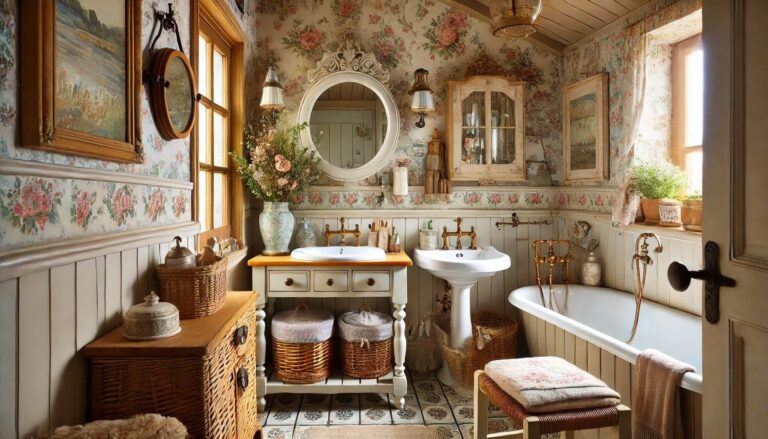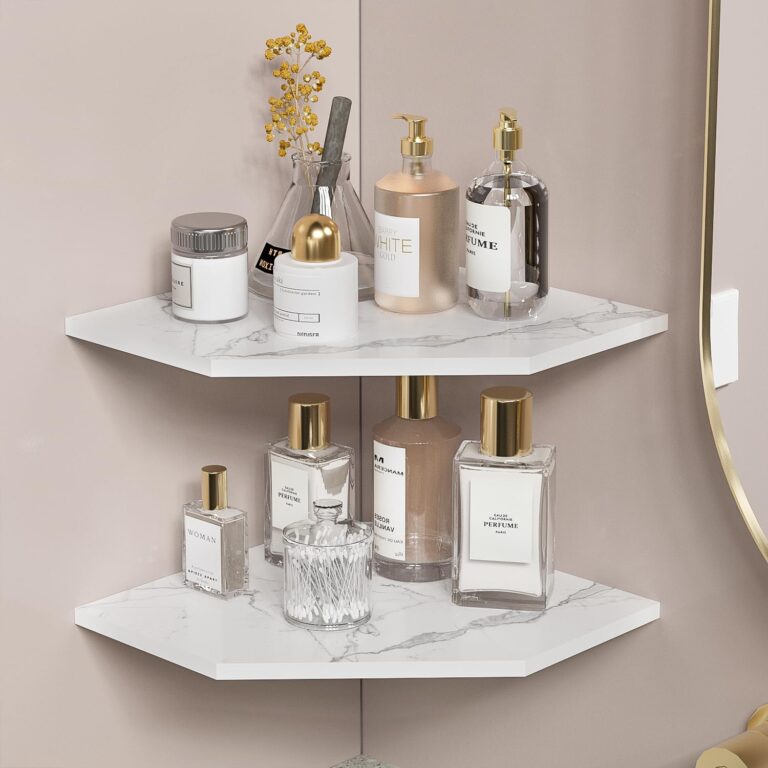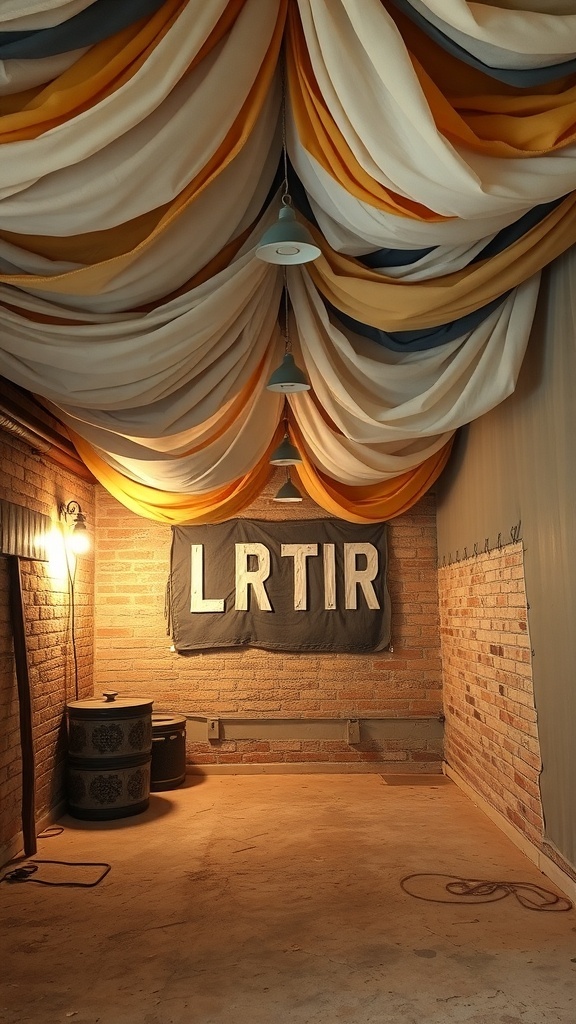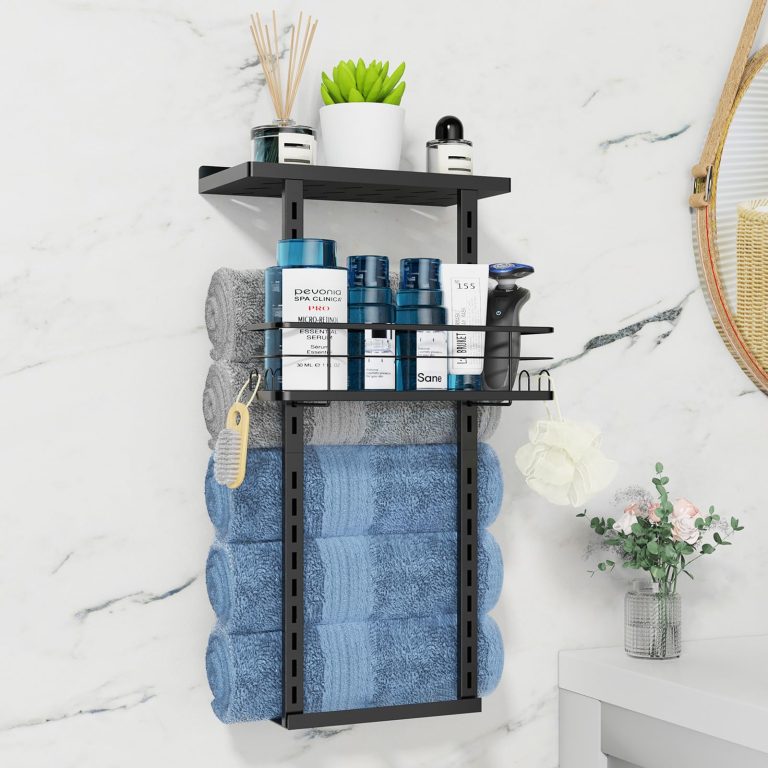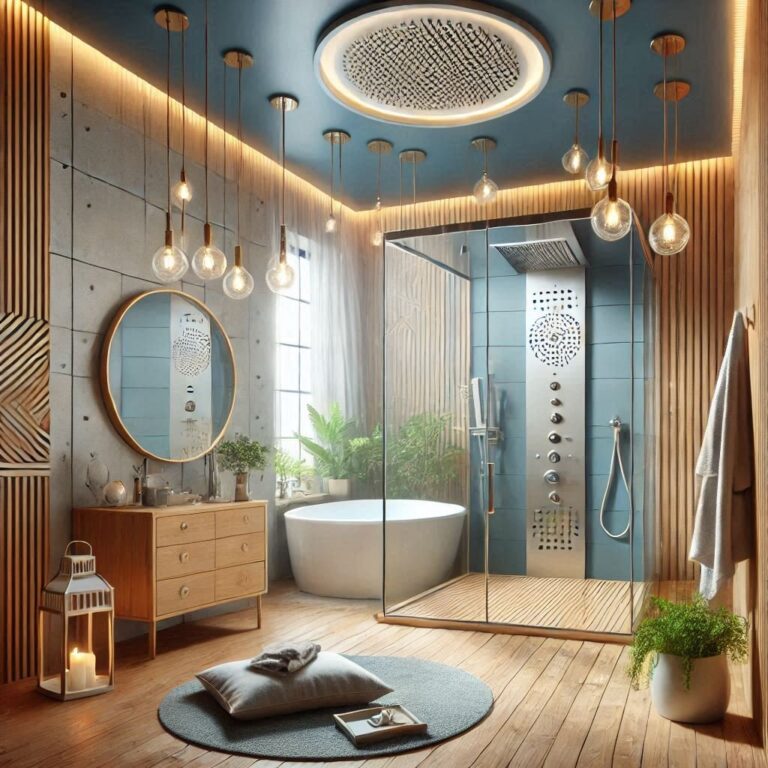19 Basement Playroom Ideas to Create the Ultimate Fun Zone
Transforming your basement into a vibrant playroom is one of the most rewarding ways to maximize unused space in your home. Whether you’re dreaming of a whimsical hideaway for toddlers, a multifunctional area for older kids, or a cozy hangout for the entire family, the right basement playroom ideas can bring joy, organization, and serious style into your space.
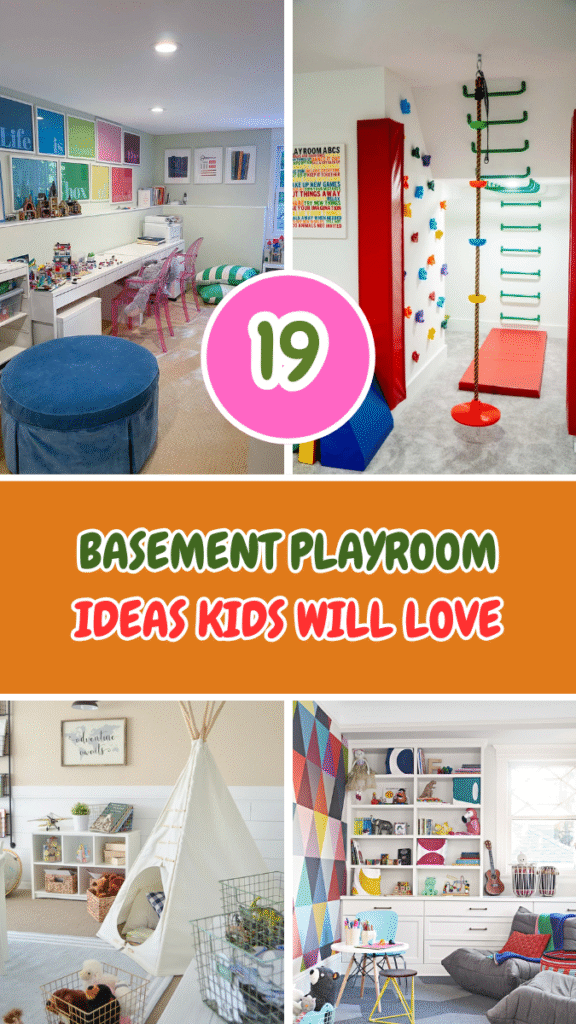
From clever storage solutions to imaginative themes and functional layouts, this guide explores 19 creative and highly practical ideas that turn your basement into a lively, welcoming retreat.
Let’s explore 10 inspiring concepts that combine fun, function, and flair — and make your basement the go-to spot for kids and grown-ups alike.
1. Indoor Treehouse Adventure
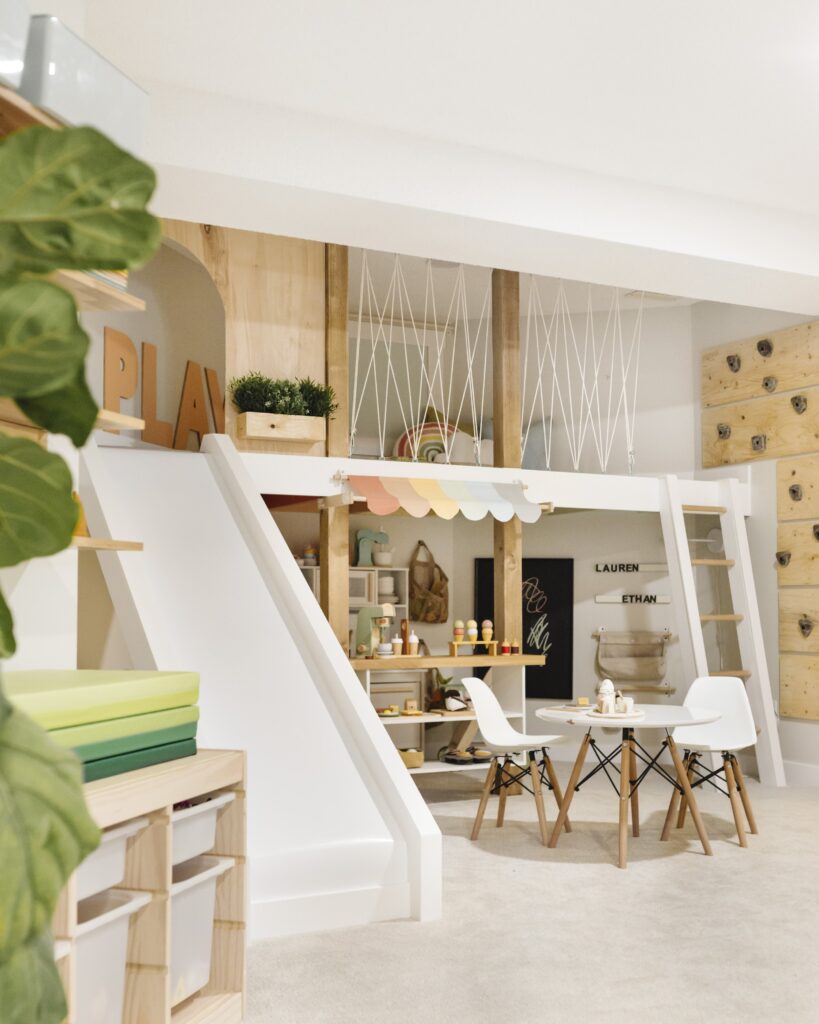
Why not bring the magic of the outdoors inside with a treehouse-themed basement playroom?
An indoor treehouse setup adds charm and excitement while encouraging imaginative play. Use wood paneling, faux branches, or tree decals on the walls to create a natural forest-like atmosphere. Add a lofted platform that mimics a treehouse deck, complete with a ladder or climbing wall and a soft slide for safe dismounts.
You can enhance the ambiance with leafy green rugs, fairy lights, and plush forest animals. Consider creating different “zones” under and around the treehouse, such as a quiet reading nook beneath the deck or a tiny craft table nearby.
This type of design works especially well in basements with lower ceilings, as it draws attention to vertical features without overwhelming the space.
For safety, ensure all climbing structures are well-supported and install foam flooring or thick rugs underneath play areas. Indoor treehouses not only inspire creativity but also promote physical activity and storytelling—making them a long-term favorite for both kids and parents.
2. Colorful Art Studio Corner
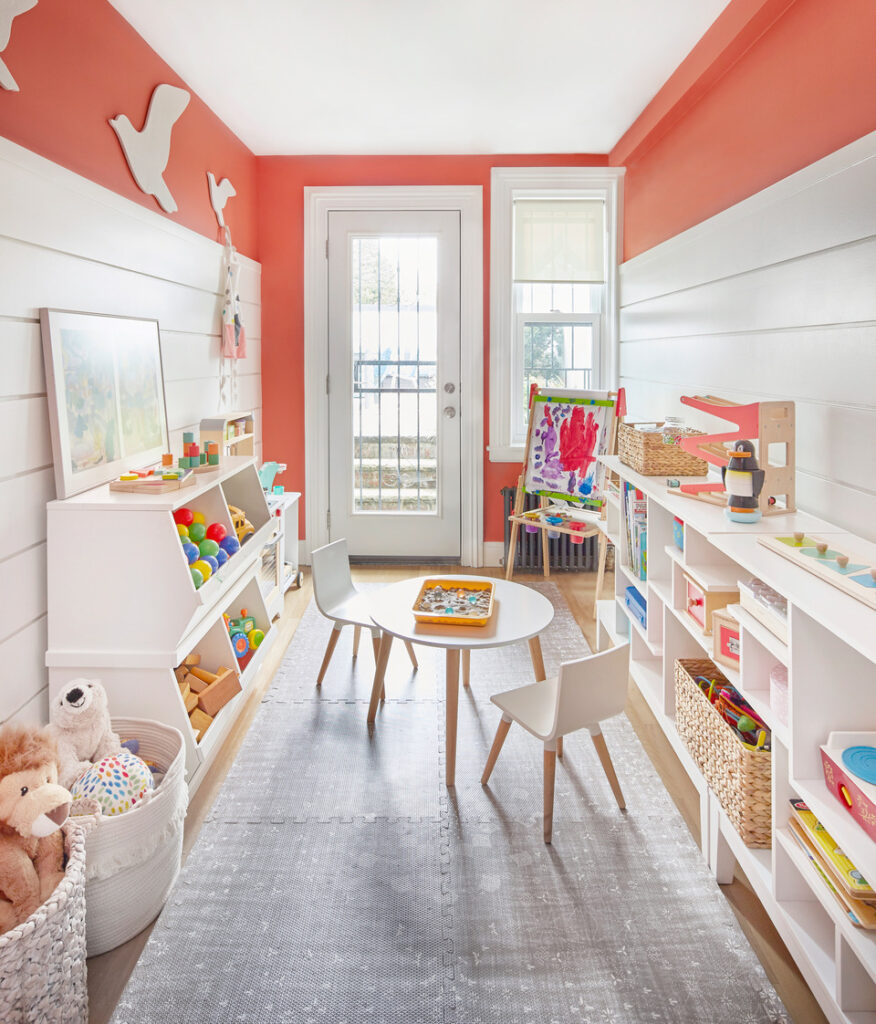
Encouraging creativity starts with creating a space that sparks imagination, and an art studio playroom corner is just the thing.
Dedicate one section of your basement to all things artsy: think easels, a chalkboard wall, washable paint stations, and kid-friendly storage for markers, crayons, and paper. Use bright, bold colors on the walls or shelves to make the space feel cheerful and energizing.
Install a countertop with built-in drawers and use pegboards for vertical organization. Hang wire displays or clipboards so your kids can show off their masterpieces with pride. Add small stools or adjustable-height tables to ensure comfort during craft time.
Make sure the flooring is easy to clean—vinyl or tile flooring with fun patterns can be both functional and decorative. You can also include an apron station or a mini sink (if plumbing allows) to make cleanup easy.
This dedicated creative space allows your children to explore self-expression in a safe, colorful environment without turning your kitchen table into a permanent art zone.
3. Cozy Reading Nook Retreat
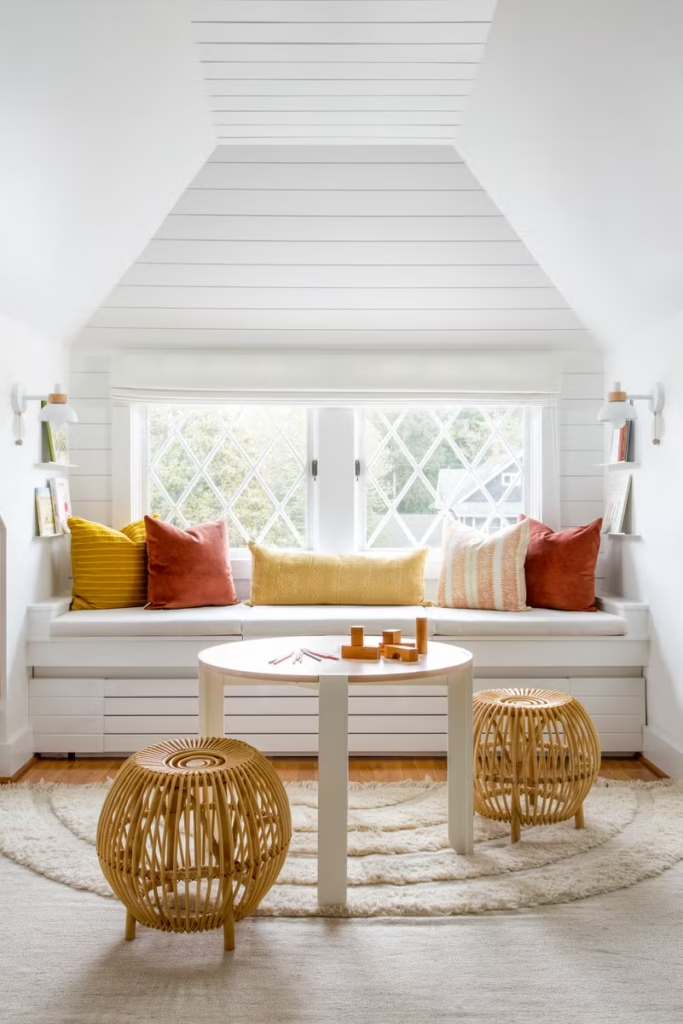
A quiet retreat in the basement for reading and relaxing is a perfect way to encourage calm time and build a love for books.
Transform a corner into a storybook paradise with floor-to-ceiling bookshelves, soft bean bags or oversized pillows, and ambient lighting. Consider building a small tent or teepee to serve as a magical hideaway that makes reading feel like an adventure.
Use warm, neutral colors and soft textures to make the area feel cozy and inviting. Add a fluffy rug or carpet tiles for comfort, and consider wall decals featuring book characters or nature scenes.
Incorporate a mix of books for different reading levels, and use bins or baskets to keep them organized. You can also label shelves to encourage kids to return books after reading.
This relaxing space helps balance high-energy play areas and promotes quiet time for children of all ages, making your basement feel balanced and thoughtfully designed.
4. Modern Sports-Themed Playroom
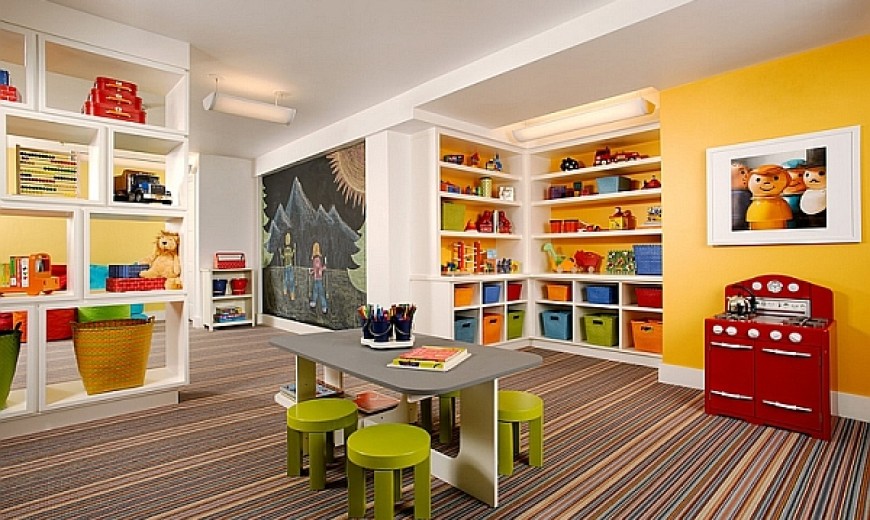
Bring the stadium to your basement with a dynamic sports-themed playroom that gets kids moving.
Whether your child is into soccer, basketball, or gymnastics, you can incorporate safe, indoor versions of these activities. Install a mini basketball hoop, climbing bars, or a fold-down gymnastics mat. Use artificial turf flooring for a sporty vibe and wall decals of their favorite teams or athletes.
Divide the space into active zones — one for climbing, one for ball games, and one for free play. A small goal post or soft play balls add fun without risk of damage.
Modern lighting, framed jerseys, or digital scoreboards can give the space a professional feel. Storage is essential here — use cubbies or benches with hidden compartments to organize gear.
This theme keeps kids engaged physically and mentally while also providing an outlet for their boundless energy. It’s especially useful during colder months when outdoor play is limited.
5. Montessori-Inspired Minimalist Design
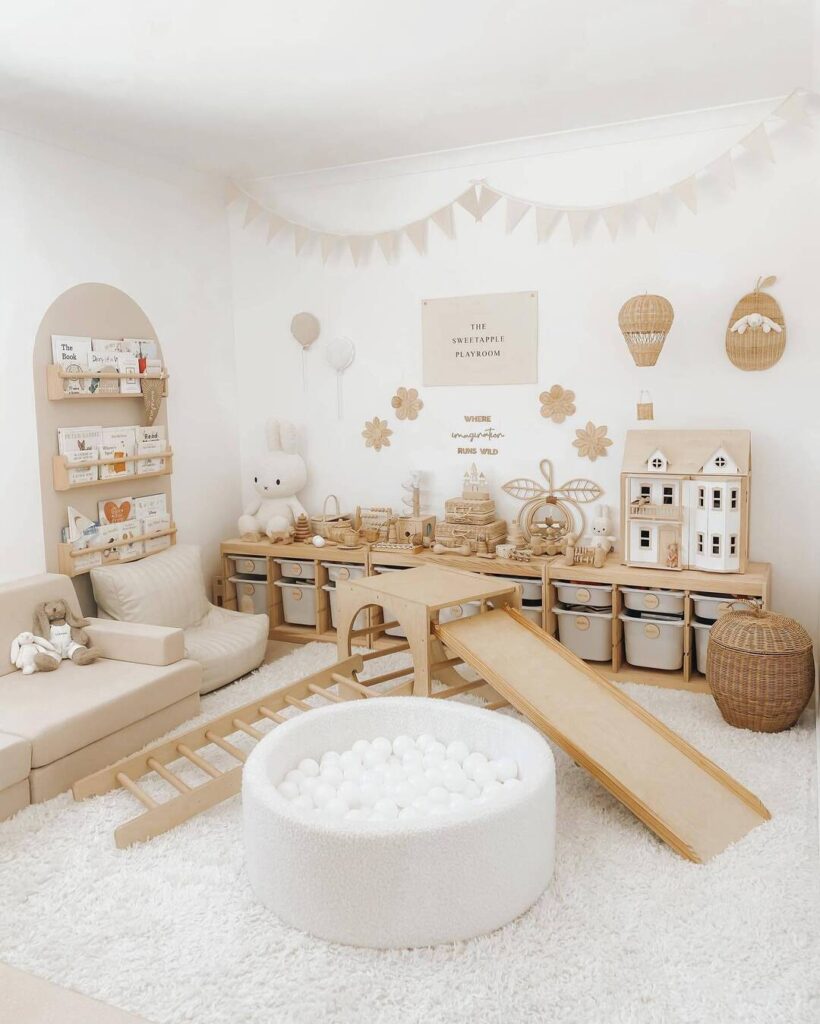
Sometimes less really is more — and a Montessori-inspired basement playroom proves it.
This style focuses on simplicity, order, and accessibility. Use low shelves to display a rotating selection of toys, learning materials, and books. Choose natural wood finishes, neutral colors, and soft textures to create a calm and inviting space that promotes independence.
Design the room in zones: a reading area, a sensory table, and a quiet space for puzzles or building blocks. Use small furniture that’s just the right height for your child, and avoid overloading the room with unnecessary décor.
Consider adding a mirror on one wall for movement activities or dance, and use baskets or clear bins for toy storage so kids can easily see and select what they want.
This intentional, calming design nurtures focus and creativity without overstimulation — ideal for toddlers and preschoolers who thrive on routine and structure.
6. STEM Exploration Station
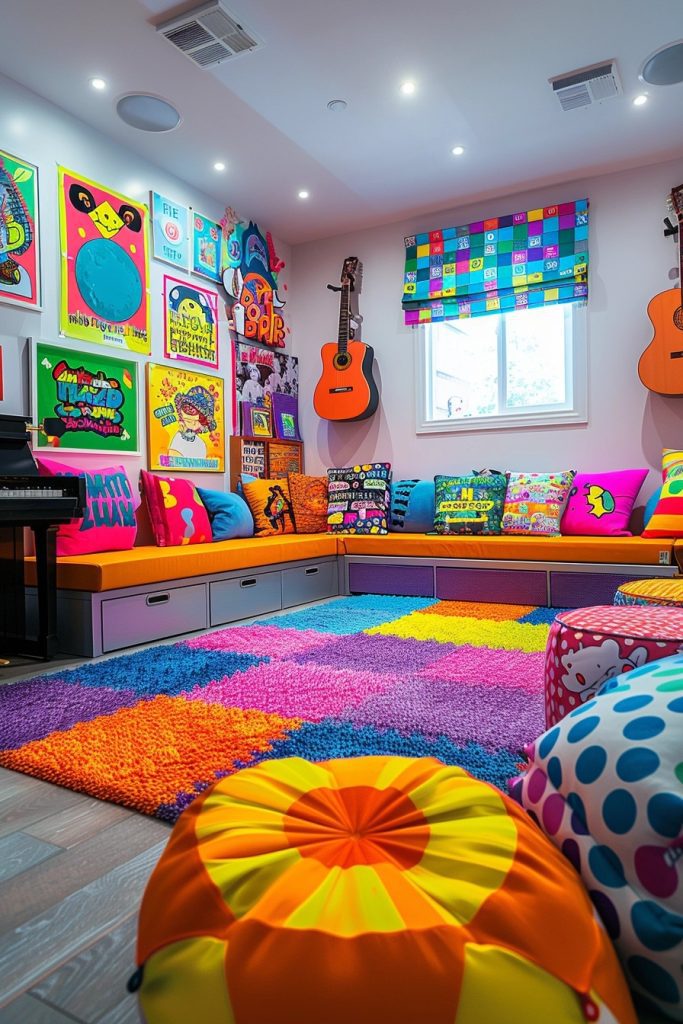
Fuel a love for science and discovery with a STEM-focused basement playroom design.
Create designated zones for building, experimenting, and observing. A central workstation with plenty of surface area gives room for science kits, building blocks, and robotic toys. Add a whiteboard for brainstorming or drawing diagrams and include labeled bins for tools and supplies.
Incorporate shelves filled with STEM books, magnifying glasses, small microscopes, and safe science experiments. Choose a color scheme that inspires curiosity — think deep blues, bright oranges, and clean whites for a modern look.
Add an electronics corner with snap circuits or coding toys and ensure good lighting for detailed work. Label everything clearly to support independent learning and tidy habits.
This setup works well for older kids and tweens, turning your basement into a hands-on learning lab that feels more like fun than schoolwork.
7. Whimsical Fantasy Land
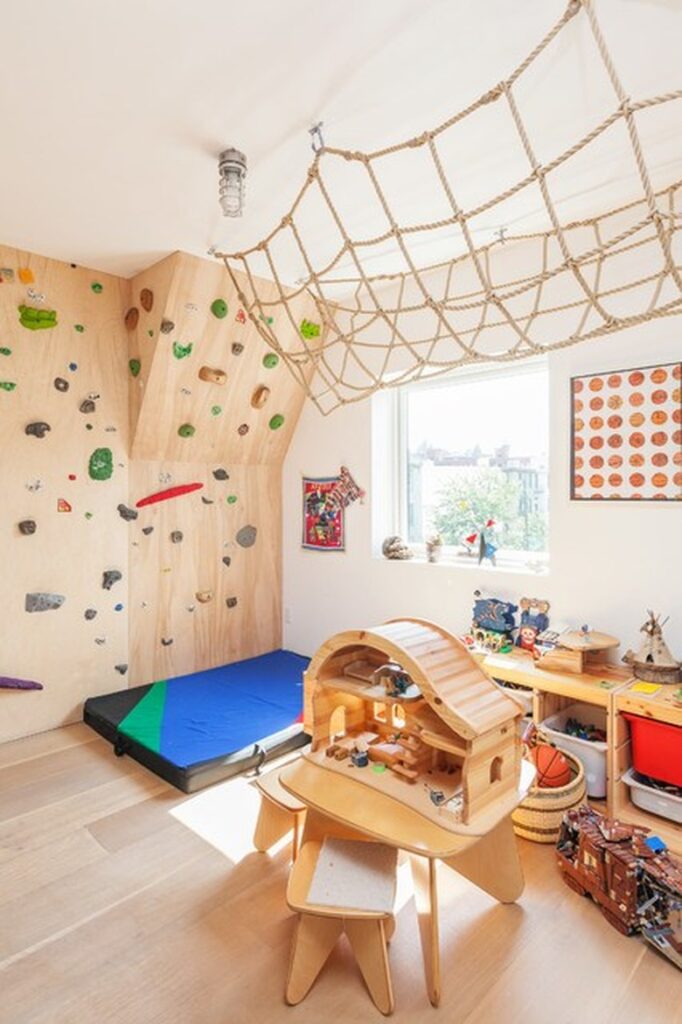
Unleash the magic of make-believe with a basement playroom that brings storybook dreams to life.
Think castles, dragons, fairies, and rainbows. Use wall murals or decals to create an enchanted backdrop. Soft, colorful rugs and flowing curtains can section off different “realms” — a castle reading corner, a magical forest craft table, or a wizard’s workshop with dress-up clothes.
Include whimsical lighting, like twinkle lights or faux chandeliers, and cozy elements like floor cushions, canopies, and fuzzy blankets.
Toy chests and dress-up racks keep costumes accessible, and labeled baskets can help organize props, dolls, and other accessories.
This theme encourages imaginative play, role-playing, and storytelling. It’s a versatile design that evolves with your child’s interests — simply swap out a few accessories to refresh the scene as they grow.
8. Rustic Farmhouse-Inspired Play Space
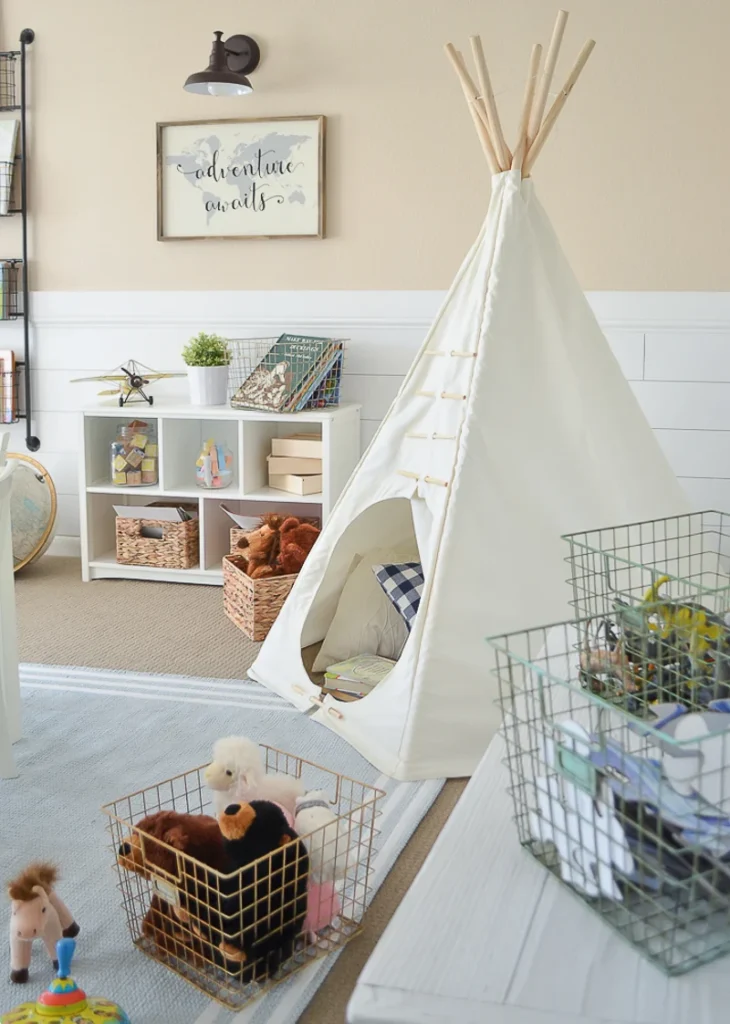
Love the charm of the countryside? A rustic farmhouse-themed basement playroom blends vintage touches with family-friendly functionality.
Use shiplap walls, distressed wood finishes, and soft plaids to set the tone. Add storage crates, vintage-style metal bins, and wooden cubbies for organizing toys and games. A miniature “barn” playhouse in one corner becomes a pretend world of its own.
Incorporate tactile elements like rope swings (with proper installation), barn doors on storage areas, and large chalkboards for drawing. Use earth-tone color palettes — think cream, sage green, dusty blue, and soft tan — for a calm yet cheerful aesthetic.
Farmhouse lighting, such as mason jar pendants or lanterns, brings in extra charm. This design works well in basements with natural wood beams or exposed brick for added character.
It’s a cozy, welcoming space with a timeless look that can transition from a toddler’s playroom into a stylish rec room later.
9. Dual-Use Media & Play Zone
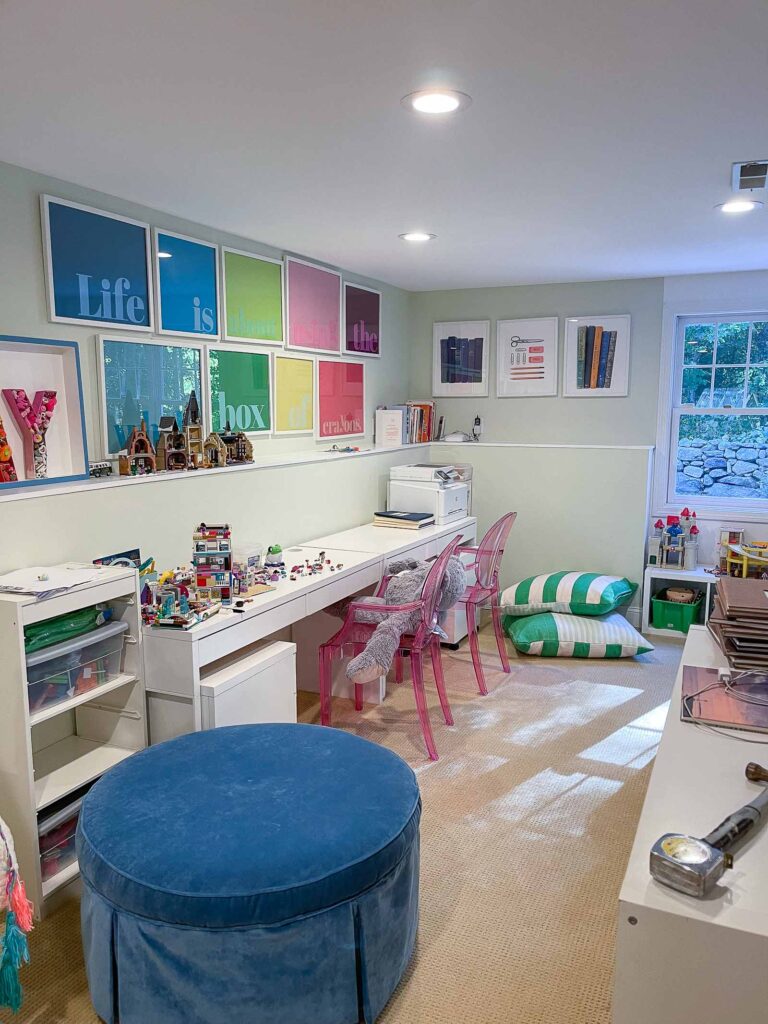
Why choose between fun and functionality when you can have both?
A dual-use playroom and media zone is perfect for families who want to blend screen time with active play. Use half the basement for a cozy TV setup with bean bags, a couch, or oversized floor cushions. The other half can be dedicated to play stations, building blocks, or a mini play kitchen.
Use shelving to define the zones and keep toys organized, while adding stylish bins to avoid clutter. Choose a modern neutral palette with pops of color through rugs or wall art for a cohesive look.
Install a projector or large flat-screen for movie nights, but keep remotes and devices out of reach when not in use. Incorporate blackout curtains and dimmable lighting for flexibility between play and downtime.
This layout grows with your kids and offers flexibility for changing needs—perfect for shared family time or solo entertainment.
10. Jungle-Themed Basement Escape
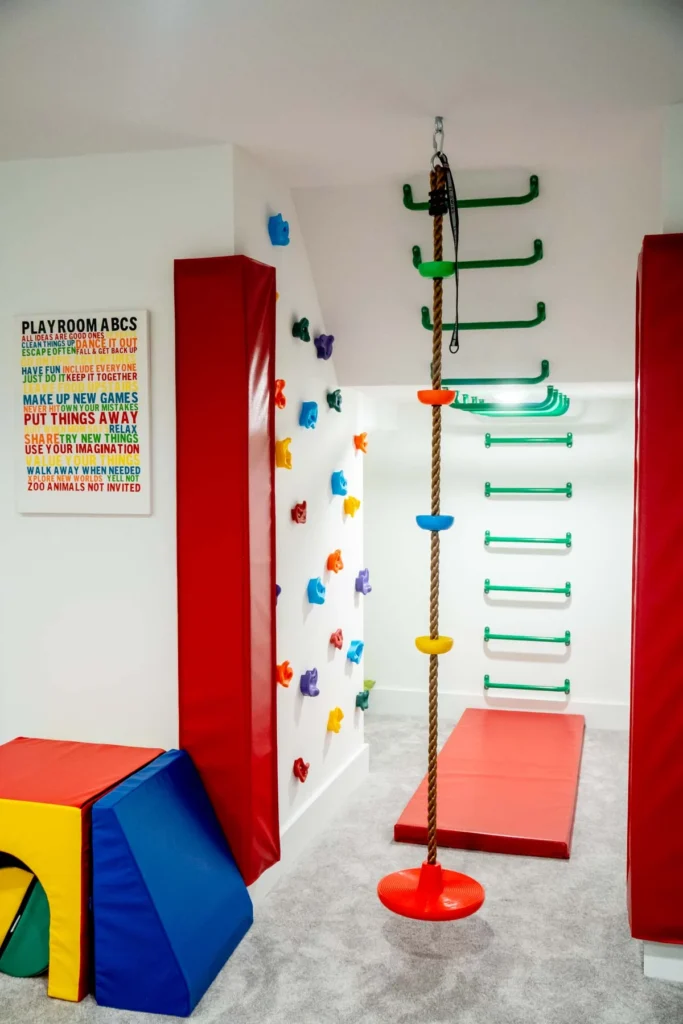
Turn your basement into a mini safari with a jungle-themed playroom packed with texture, color, and movement.
Start with a base of green and brown tones on the walls and floors. Add large leaf decals, tropical plant prints, or even a palm tree mural. Hang vines from the ceiling, and use animal-themed rugs and cushions for immersive flair.
Consider a climbing wall, rope ladder, or soft monkey bars (with proper padding underneath) for indoor adventure. A tent or hammock chair adds a cozy spot to rest, while bins shaped like animals or trees offer fun storage solutions.
You can even install sounds of jungle birds or gentle music to enhance the experience. Keep furniture low and rounded for safety and accessibility.
This lively space brings outdoor energy into your home, helping kids burn energy and engage in pretend play year-round.
11. Under-the-Sea Playroom
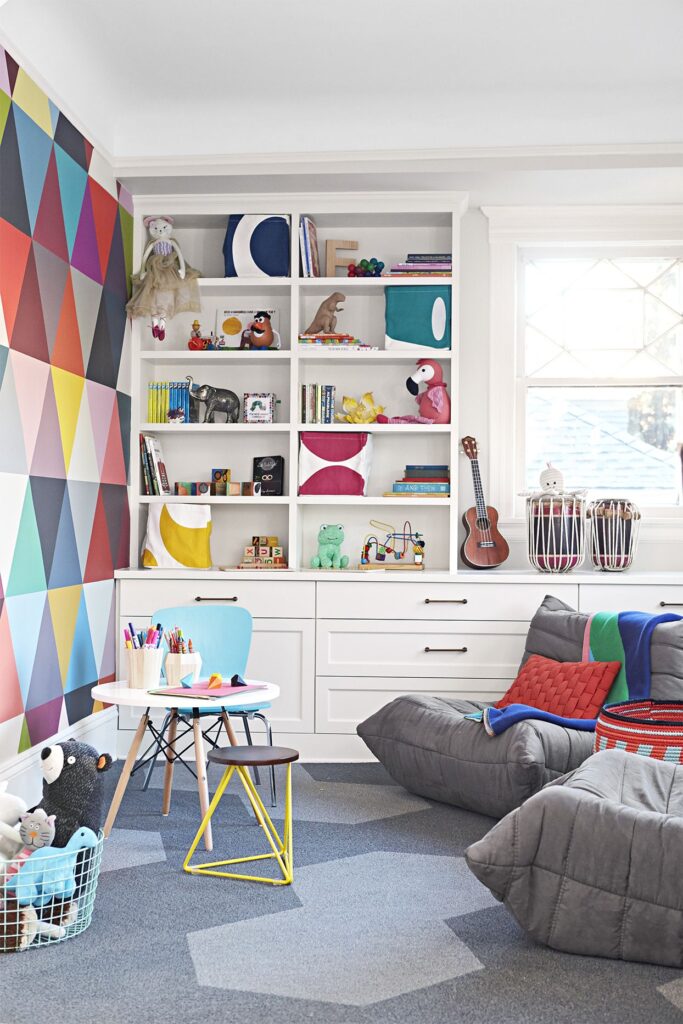
Make a splash with an underwater-themed basement playroom that brings the magic of the ocean indoors.
Start by painting the walls in deep blues and teals to mimic the sea, or opt for an ocean mural with whales, dolphins, and coral reefs. Hang fabric or streamers from the ceiling to simulate ocean currents, and incorporate porthole decals or faux submarine windows for added whimsy.
Use sea creature plush toys, floor cushions shaped like shells, and ocean-themed rugs to complete the look. A sensory sand or water table can provide hands-on learning, while toy storage in netted baskets or boat crates adds functional flair.
Include a reading nook with a “sunken treasure” theme or mermaid cove draped in gauzy fabrics. Lighting should be soft and dreamy — think string lights shaped like bubbles or jellyfish.
This design not only sparks creativity but also helps children unwind in a calming, nature-inspired environment. The sea theme works beautifully with sensory play and offers plenty of room to evolve as your children grow.
12. Indoor Climbing and Obstacle Course
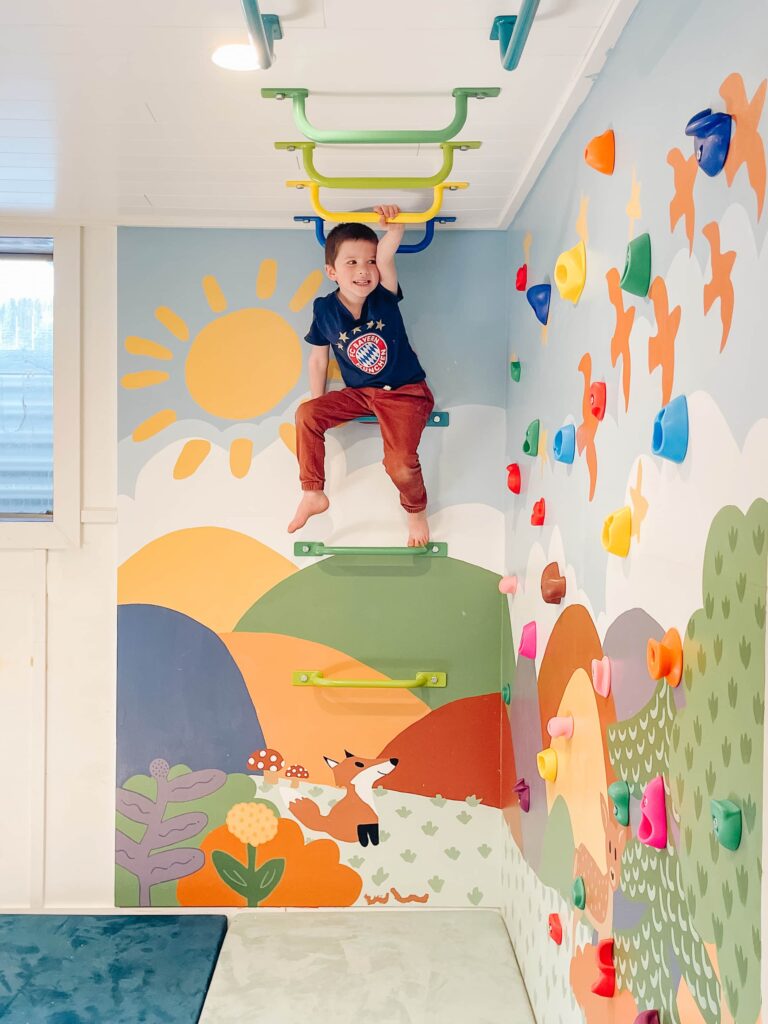
Turn your basement into a mini gym with a soft and safe climbing space and obstacle course.
Perfect for active kids, this design focuses on physical movement and coordination. Start with foam flooring or interlocking mats to create a cushioned play surface. Install features like a rock climbing wall, rope swing, hanging rings, or balance beams — all tailored to fit your basement’s ceiling height and layout.
Use bright, primary colors to energize the space, and incorporate padded walls or crash mats for safety. You can even rotate the setup occasionally to keep things fresh and challenging.
Add storage bins for accessories like cones, bean bags, or timers, and consider a whiteboard to track progress or write fun challenges.
An indoor obstacle course encourages strength, agility, and confidence — making it a great option during winter months or rainy days when outdoor play isn’t possible.
13. Interactive Wall Play
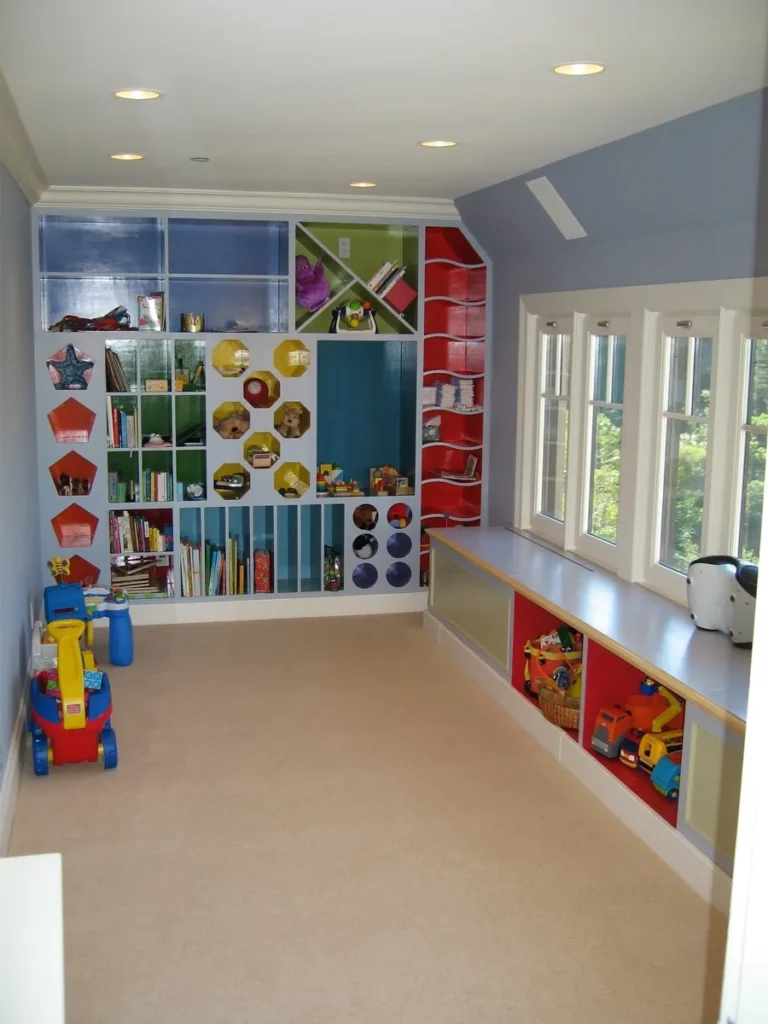
If you’re short on space but big on ideas, an interactive wall play area is the solution you didn’t know you needed.
Think pegboards with movable pieces, wall-mounted busy boards, magnet or chalk walls, and puzzle panels that invite hands-on play without taking up floor space. Use a portion of the basement wall and turn it into a rotating activity center your kids can grow with.
Install interchangeable panels so you can swap themes from dinosaurs to letters to STEM activities. Add shelves underneath to hold small containers with manipulatives or puzzles. You can even include a felt board or whiteboard for creative expression.
This setup works especially well in narrow basements or when you’re combining a play area with storage or media zones. It keeps things vertical, neat, and out of the way — yet endlessly fun and educational.
14. Vintage-Inspired Toy Room
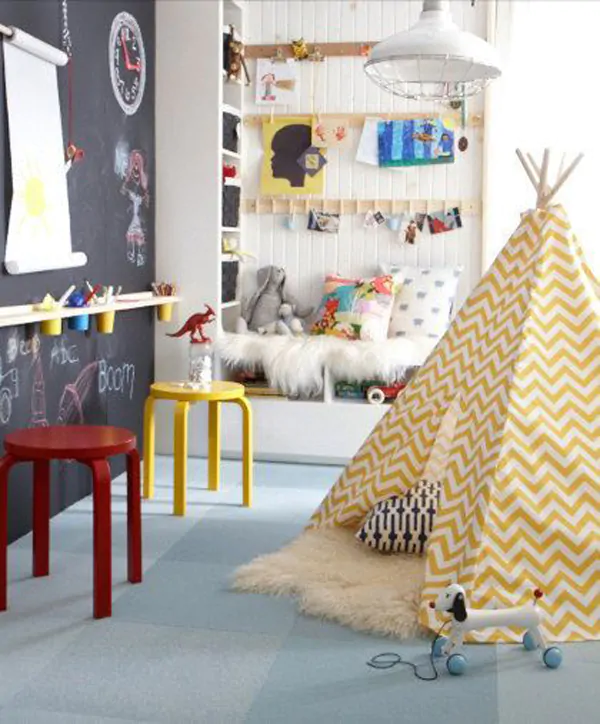
Bring a touch of nostalgia into your basement with a vintage-inspired toy room that both kids and adults will love.
Decorate with retro toys, classic wooden blocks, and timeless games like trains, dollhouses, and marbles. Use antique-style shelves and metal bins for organizing while adding decorative touches like framed vintage ads or old-school circus posters.
Incorporate timeless color schemes — think mustard yellow, faded red, and navy — and natural materials like wood, linen, and cotton. Floor rugs in checkered or striped patterns evoke classic playroom vibes while keeping the space warm and cozy.
This idea works beautifully in homes with farmhouse or mid-century modern décor, and it grows well with your children since the overall style is mature, charming, and versatile.
It’s a meaningful way to create a warm, inviting space where grandparents and parents can share their favorite games and memories with a new generation.
15. Themed Dress-Up and Performance Stage

If your child loves putting on shows, give them the spotlight with a dress-up and performance-themed basement playroom.
Designate a corner of the basement as their personal stage, complete with a small raised platform, velvet curtains, and twinkle lights. Add a mirror with lights for a backstage vanity feel, and include racks or bins for dress-up clothes, props, and accessories.
Incorporate themed costumes — from superheroes and fairytale characters to pirates and pop stars — and keep everything organized in labeled baskets or hooks. Add a chalkboard or dry erase board where they can write the day’s “show schedule.”
This type of playroom encourages social interaction, creativity, and confidence as kids take center stage. Bonus: It’s a fun space for family skits, karaoke nights, or school presentations, too.
16. Scandinavian-Style Playroom
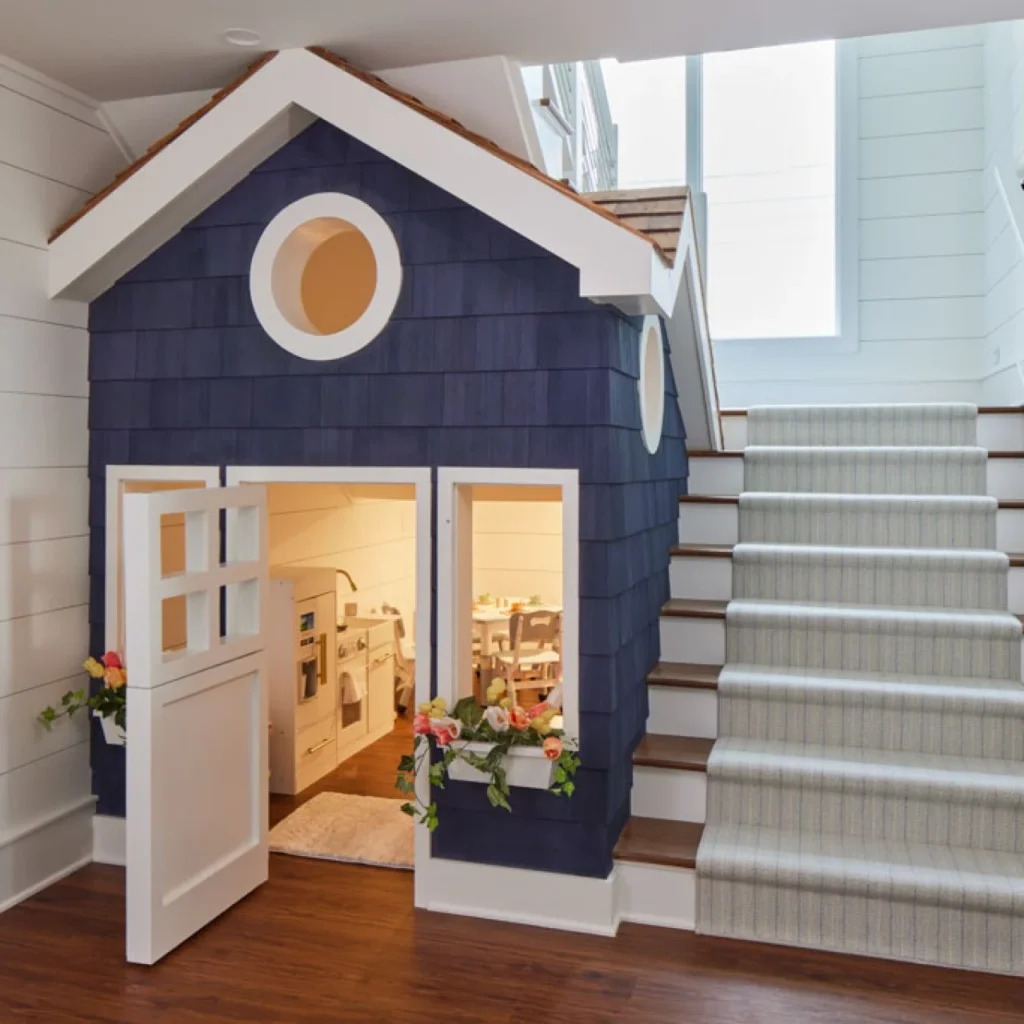
Clean, modern, and oh-so-functional — a Scandinavian-style basement playroom offers a minimalist aesthetic with maximum charm.
Start with a neutral color palette of whites, grays, and light woods. Choose simple, functional furniture and soft textures like sheepskin rugs, felt cushions, and woven baskets. Keep décor minimal but meaningful: a few art prints, playful lighting, or a tented reading nook.
Use modular toy storage with clear bins, and consider furniture that grows with your child — such as adjustable tables and chairs or convertible play structures.
This calm, well-organized style reduces visual clutter, making it easier for kids to focus and play independently. It’s a great match for families who value simplicity, modern aesthetics, and an overall sense of peace in their home’s design.
17. DIY Building Block Zone
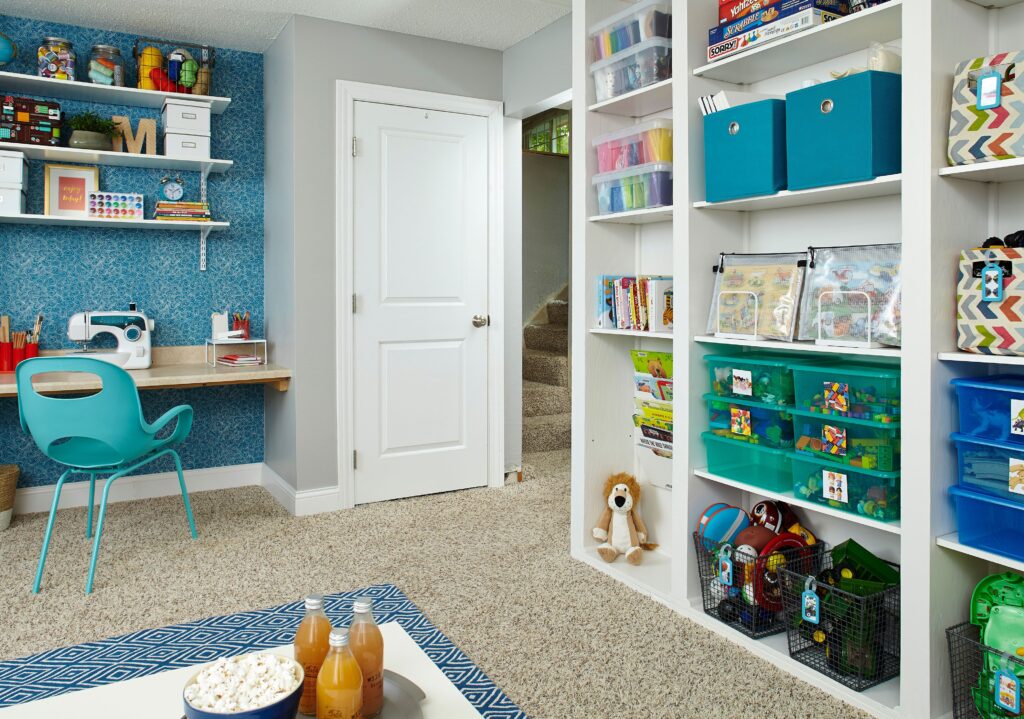
Perfect for budding engineers and future architects, a DIY building block zone gives kids a place to build big and dream bigger.
Create a section of the basement that’s dedicated to LEGOs, magnetic tiles, or wooden building blocks. Use a flat work table with divided compartments or drawers, and label each bin by color, size, or set.
Add wall-mounted baseplates for vertical LEGO creations, and hang inspirational posters or photos of famous buildings and landmarks.
Use stackable storage cubes and a color-coded organization system to keep everything accessible and tidy. Add a bulletin board or cork wall where kids can display their favorite designs or ongoing projects.
This type of playroom promotes creativity, problem-solving, and fine motor skills — and it’s easy to update as your child’s interests evolve. It’s also a great shared space for kids who like different types of construction or STEAM-based activities.
18. Family-Friendly Game and Puzzle Room
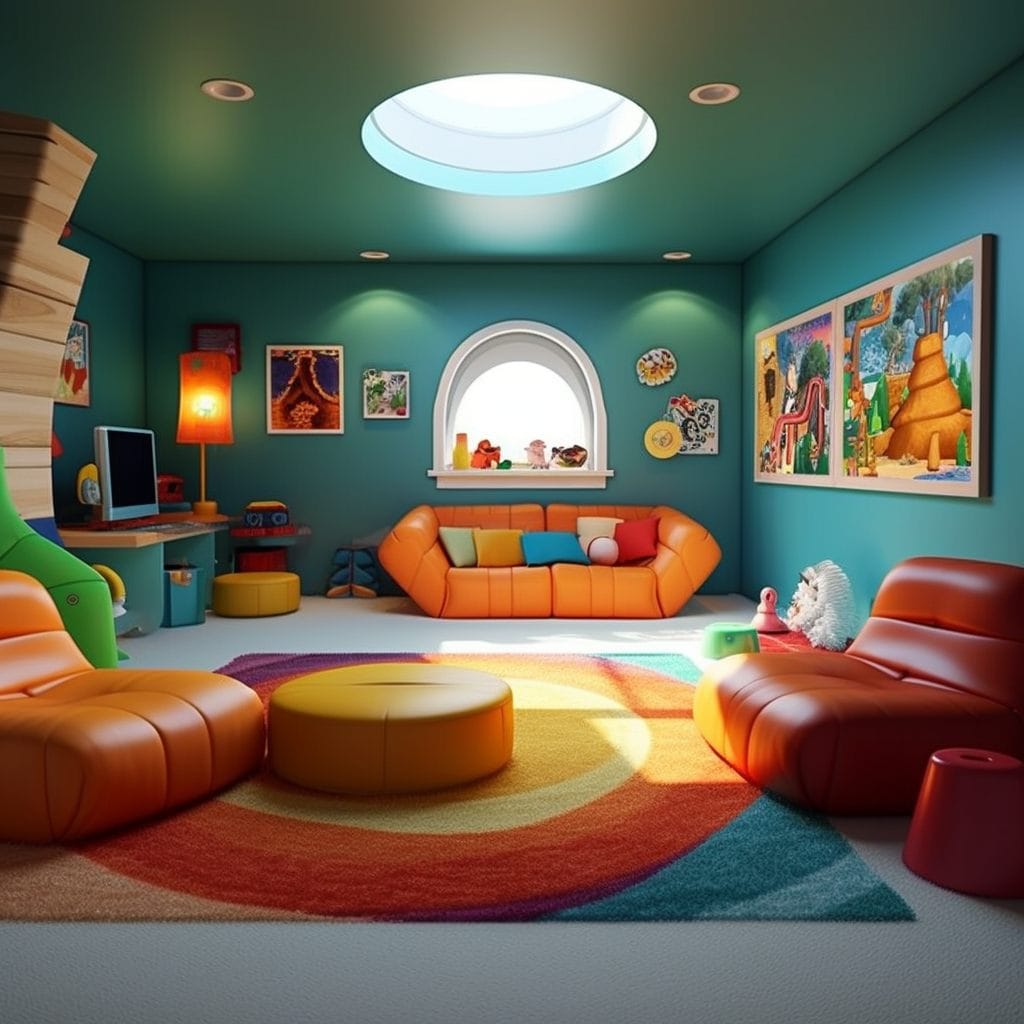
Create a cozy, collaborative space where the whole family can gather for games, puzzles, and bonding time.
Install a central table for board games and puzzles, surrounded by comfy chairs or floor cushions. Use built-in storage or bookcases to organize your game collection, and keep a few cozy blankets on hand for extra comfort.
Choose warm lighting and calming tones — soft blues, grays, and earth tones work well. Add artwork with inspirational quotes or vintage game prints to personalize the space.
You can even create a “game wall” with shelves for games, sand timers, and card trays. Include a chalkboard scoreboard or magnet board for keeping track of wins.
This space doesn’t just keep the kids entertained — it creates a perfect spot for Friday night family fun, making the basement a true extension of your living space.
19. Nature-Inspired Sensory Room
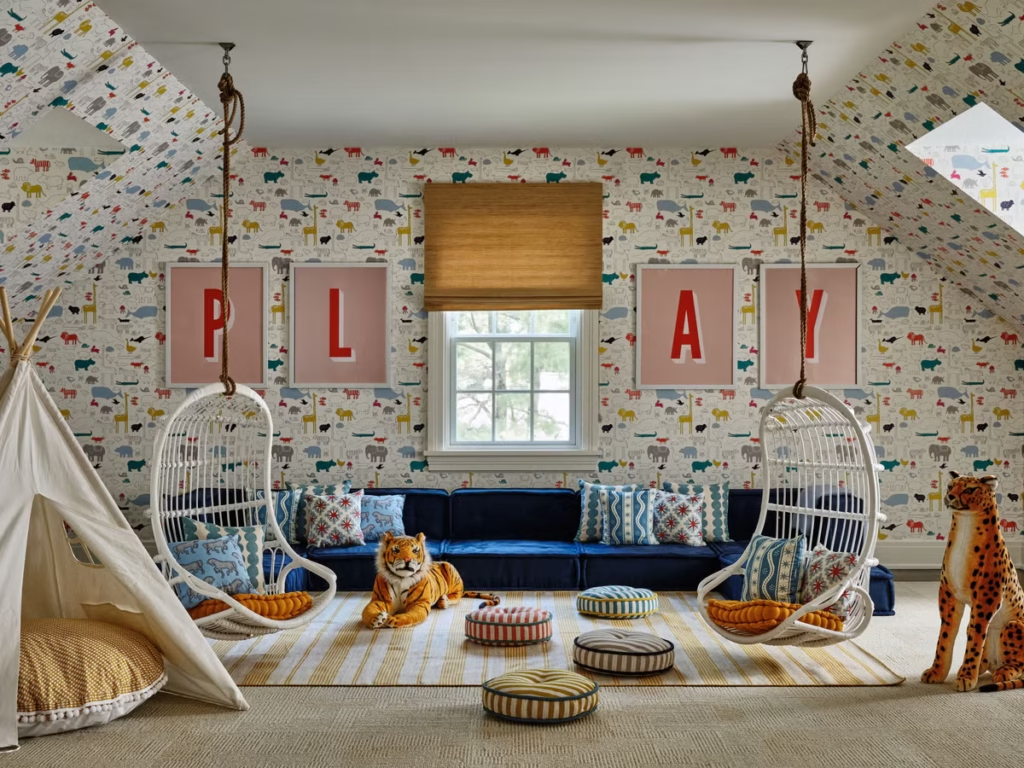
A nature-inspired sensory room is ideal for children who benefit from soothing sensory experiences — and it can double as a calming retreat for the whole family.
Use earthy tones and nature textures like woodgrain flooring, moss-green rugs, and stone-inspired wallpaper. Add sensory toys, tactile wall panels, soft swings, or hanging cocoon chairs. Light projectors that mimic stars or gentle water movement can create a serene atmosphere.
Include elements like sound machines, lava lamps, bubble tubes, and weighted blankets for multisensory exploration. For kids who need sensory input or downtime, this kind of room offers invaluable benefits.
Label storage bins with visuals for easy clean-up and ensure all materials are soft and safe. A soft mat in the center of the room can serve as the main relaxation zone, with calming books and plush animals nearby.
This idea promotes mindfulness, relaxation, and gentle stimulation — and it can be personalized for kids with sensory processing needs or simply for those who enjoy tranquil, quiet moments.
Conclusion: Designing a Basement Playroom That Grows With Your Family
Creating a basement playroom is more than just a weekend project — it’s a chance to design a space where memories are made, creativity flourishes, and kids feel truly at home.
Whether you’re leaning toward a rustic farmhouse style, a STEM lab, or a whimsical fantasy land, each of these 19 ideas offers endless ways to transform your basement into something special.
Keep functionality at the forefront by using smart storage solutions, low-maintenance materials, and flexible layouts that evolve with your child’s needs. Don’t forget to infuse your family’s personality into every corner — whether that’s through art, lighting, or color palettes that reflect your style.
With the right balance of fun and practicality, your basement can become one of the most beloved and functional spaces in your home — not just for your kids, but for the whole family to enjoy.
